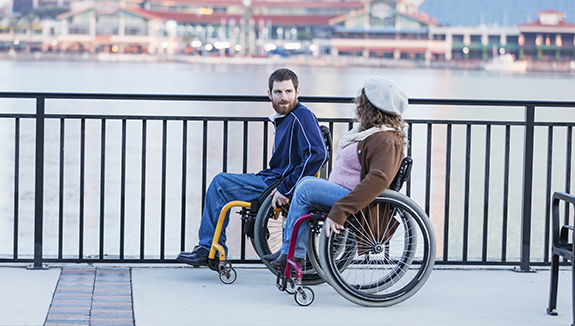Your Nervous System and How It Works
Your nervous system is complex, but some fundamental knowledge can give you deeper insight into your injury. Explore the basics and learn more about spinal cord injuries.

Learn about your nervous system and spinal cord injuries.
If you’ve recently had a spinal cord injury, it may be helpful for you to understand the way a healthy nervous system functions. That way you can better understand your injury and feel more in control.
Nervous system basics
The three critical components of the nervous system are the brain, the spinal cord, and the nerves. These parts communicate with each other and work together to help you move your body, feel pressure, and control body functions like breathing, bowels, bladder, and blood pressure.
- The brain: This is the “command center” that processes information from all over the body. The brain receives and sends signals to muscles, organs, and other structures to control bodily functions.
- The spinal cord: This is the largest nerve in the body. It is about 18 inches long, and extends from the base of the brain down the middle of the back to the waist. The vertebral column is a bony structure that surrounds and protects the spinal cord, and is divided into sections.
- The nerves: These are cord-like structures made up of nerve fibers. Nerve fibers are specialized cells that carry messages from one part of the body to another.
Complete vs. incomplete spinal cord injuries
When the spinal cord is injured, the nervous system can’t communicate the way it is supposed to. The nerves above the injury work fine, but the ones at and below the injury can’t receive or send messages properly. Sometimes all the messages stop, so there is no movement or sensation (feeling) below the level of the injury.
The severity of an injury is described as “complete” or “incomplete.” A complete injury means all functions below the injured area are lost. If the injury is incomplete, there is still some sensory or motor function below the injured area. To be classified as incomplete, there must be some function coming from the spinal cord section labeled S4 and S5 (see illustration below).
Your healthcare provider will run several tests to find out whether your injury is complete or incomplete. The completeness of your injury may change over time, so you may go through several rounds of tests.
Types of spinal cord injuries
The movement or function you may have lost depends on the location of the injury in your spinal cord (see chart). There are three common types of spinal injuries:
- Paraplegia is a type of paralysis affecting the legs and lower part of the body. It usually occurs with injuries at T2 or below.
- Tetraplegia paralysis affects levels below the neck involving both the arms and legs. It usually occurs with injuries at T1 or above.
- Triplegia injuries cause loss of sensation and movement in one arm and both legs. Triplegia is typically the result of an incomplete spinal cord injury.
Below is a partial list of the spinal segments, and the bodily functions they impact:
| Spinal Segment | Functions Impacted |
| C1-3 | Head control |
| C5 | Lifting arm with shoulder, elbow flex |
| C8 | Finger flex |
| T2-T12 | Deep breathing |
| L1-L2 | Hip flex |
| L3-L4 | Knee extension |
| S1 | Movement of foot and ankle |
| S2-S5 | Function of bladder and bowel |

Assessing your injury
Your doctor will be able to assess the completeness of your injury, as well as the type of spinal cord injury you’ve sustained. Once all the tests have been done, you’ll discuss where you may have lost function and what to expect going forward. Your doctor can also tell you whether you may be able to get some function back over time.
If you have questions, talk to your healthcare team. They may also be able to guide you to additional resources.




